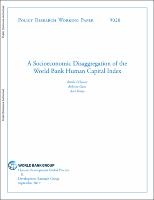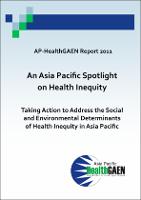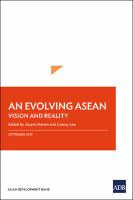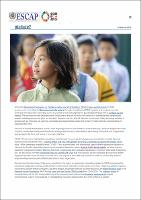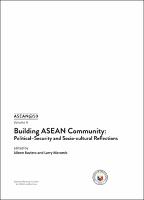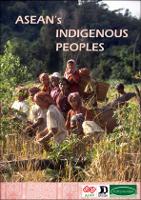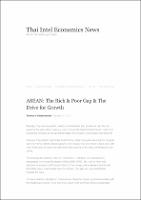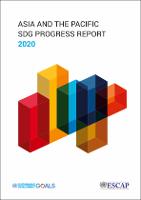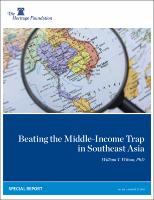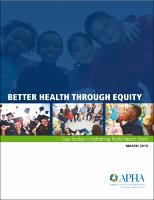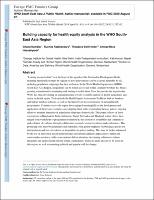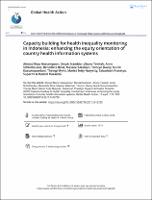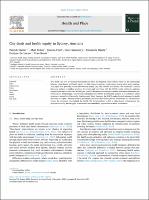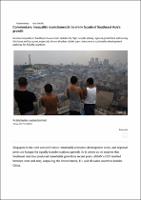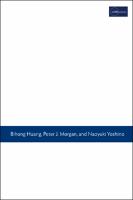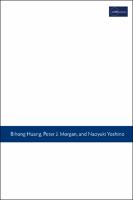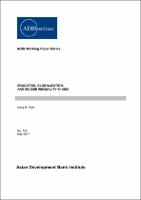Browsing 1.03.02 Economic, Social & Political Context by Title
Now showing items 1-20 of 48
-
A Socioeconomic Disaggregation of the World Bank Human Capital Index
(World Bank, Washington, DC, 2019-09)
This paper documents inequality in health and education outcomes by constructing an index of human capital disaggregated by quintiles of socioeconomic status (SES) for a sample 51 mostly low- and middle-income countries. The index measures the expected future human capital of children born today, following the methodology of the World Bank Human Capital Index that was launched in October 2018. Within-country disparities in human capital outcomes across SES quintiles are large, accounting for roughly one-third of the total variation. On average, ... -
An Asia Pacific Spotlight on Health Inequity: Taking Action to Address the Social and Environmental Determinants of Health Equity in Asia Pacific
(2011)
In the full report we describe the extent of health inequities between and within countries across the Asia Pacific region. We explore the plausible causal relationships between social and environmental factors and health inequities and describe actions that are taking place to improve health inequities in Asia Pacific. The report is based on pre-existing data policy-mapping case studies and expert knowledge from across the region. We have drawn upon reports and peer-reviewed publications from a diversity of disciplines such as public health ... -
An evolving Asean: vision and reality
(Asian Development Bank, 2019-09)
This volume is a compilation of the papers presented at the High-Level Workshop on the Evolving Nature of ASEAN’s Economic Cooperation: Original Vision and Current Practice, containing the authors’ personal reflections on ASEAN’s journey toward economic integration. The papers review the historical evolution of ASEAN’s economic agenda, capture its achievements, examine the challenges that have surfaced in the last decade, and recommend a way forward. The papers in this volume emphasize that, while there have been notable successes, the remaining ... -
Are we REALLY getting everyone into the picture?
(2021-03-26) -
ASEAN @50Volume 4: Building ASEAN Community: Political-Security and Socio-cultural Reflections
(ERIA, 2017)
ASEAN has gradually built, on the basis of both shared interests and common principles and norms, various practices and mechanisms that helped prevent conflict among its members and allowed it to play an autonomous role in shaping the regional security architecture. Overcoming the member states' preoccupation with their own national concerns to give way to advocacy of collective interests has remained difficult, but progress is being made. Part A of this volume looks at the processes and dynamics, challenges, and opportunities of ASEAN ... -
ASEAN's Indigenous Peoples
(AIPP,IWGIA,FORUM-ASIA, 2010)
Indigenous Peoples are not at all mentioned or referred to in any ASEAN document, even though they are an integral part of the ASEAN Community and among its most vulnerable sectors, whose interest the ASEAN has committed itself to protect. The failure of the ASEAN to address the plight of its Indigenous Peoples despite its expressed commitment to human rights and social justice is a shortcoming that needs to be corrected urgently. Unless Indigenous Peoples are fully recognized as integral part of a culturally diverse ASEAN, and unless Indigenous ... -
ASEAN: The Rich & Poor Gap & The Drive for Growth
(2014-02-17) -
Asia and the Pacific SDG progress report 2020.
(United Nation, 2020)
This report analyses trends as well as data availability for monitoring progress toward the Sustainable Development Goals (SDGs) in Asia and the Pacific and its five subregions. It assesses gaps which must be closed to achieve the goals by 2030. This assessment is designed to ensure the region’s actions remain on target, shortcomings are addressed as they arise, and all interested parties remain engaged. It is an invaluable resource for all stakeholders involved in prioritization, planning, implementation and follow-up of the 2030 Agenda for ... -
Beating the Middle-Income Trap in Southeast Asia
(The Heritage Foundation, 2014)
Since 2000, Southeast Asia has had some of the fastest growing economies in the world. Indonesia’s economy has enjoyed 6 percent annual growth—but will its lack of infrastructure and its commodity dependence soon reveal some cracks in its economy? The remarkable growth in the Philippines will not last unless domestic investment is elevated. Thailand’s growth has stalled amid political turmoil, and it is currently in a classic credit bubble. Vietnam still generates impressive growth, but it has a banking problem, high inflation, and ubiquitous ... -
Better Health Through Equity: Case Studies in Reframing Public Health Work
(American Public Health Association, 2015)
The efforts chronicled in this series of case studies are not only designed to improve health outcomes, they are also poised to save the country billions in health care spending. According to one study published in 2009, more than 30 percent of direct medical costs faced by African Americans, Hispanics and Asian Americans can be tied to health inequi- ties. Because of inequitable access to care, these populations are sicker when they do find a source of care and incur higher medical costs. That 30 percent translates to more than $230 billion over ... -
Building capacity for health equity analysis in the WHO South-East Asia Region
(2019)
Leaving no one behind” is at the heart of the agenda of the Sustainable Development Goals, requiring that health systems be vigilant to how interventions can be accessed equitably by all, including population subgroups that face exclusion. In the World Health Organization (WHO) South-East Asia Region, inequalities can be found across and within countries but there has been a growing commitment to examining and starting to tackle them. Over the past decade in particular, WHO has been developing an armamentarium of tools to enable analysis of health ... -
Capacity building for health inequality monitoring in Indonesia: enhancing the equity orientation of country health information systems
(2018)
Background: Inequalities in health represent a major problem in many countries, including Indonesia. Addressing health inequality is a central component of the Sustainable Development Goals and a priority of the World Health Organization (WHO). WHO provides technical support for health inequality monitoring among its member states. Following a capacity-building workshop in the WHO South-East Asia Region in 2014, Indonesia expressed interest in incorporating healthinequality monitoring into its national health information system. Objectives: This ... -
City deals and health equity in Sydney, Australia
(2022-01)
City Deals’ are new governance instruments for urban development. Vast evidence exists on the relationship between urban factors and health equity, but little research applies a health equity lens to urban policy-making. This paper does precisely that for the Western Sydney City Deal (WSCD) in Australia. We conducted a critical discourse analysis of publicly available documents and interviews with the WSCD’s main architects, applying insights from relevant theories. We find ‘pro-growth’ discourse to encourage economic investment dominates any ... -
Commentary: Inequality looms beneath the shiny facade of Southeast Asia's growth
(CNA, 2017-04-23) -
Costa Ricans Live Longer Than Us. What’s the Secret?
(2021-08-30) -
Demystifying rising inequality in Asia
(Asian Development Bank Institute, 2019)
Income inequality is one of the most profound social, economic, and political challenges of our time. The gap between the rich and the poor has been regarded as a major concern for policy makers. This gap is at its highest level in decades for developed economies, while the inequality trend has been rising in many developing countries. In Asia, despite recent economic growth, income distribution has been worsening as well. This book contributes to the existing literature on inequality in Asia by overviewing the new trend of inequality in Asia and ... -
Demystifying rising inequality in Asia
(Asian Development Bank Institute, 2019)
Income inequality is one of the most profound social, economic, and political challenges of our time. The gap between the rich and the poor has been regarded as a major concern for policy makers. This gap is at its highest level in decades for developed economies, while the inequality trend has been rising in many developing countries. In Asia, despite recent economic growth, income distribution has been worsening as well. This book contributes to the existing literature on inequality in Asia by overviewing the new trend of inequality in Asia and ... -
Education, Globalization, and Income Inequality in Asia
(Asian Development Bank Institute, 2017-05)
This study considers how education and globalization affect income inequality in Asia, with unbalanced panel data. The evidence supports the validity of Kuznets’ inverted-U hypothesis for the connection between income level and income inequality. However, when more variables are integrated into the model, the consistency of the inverse U-shaped curve becomes weaker. The empirical results suggest that educational variables are highly influential in affecting income distribution. Our analysis indicates that a higher level of education achieved by ...

